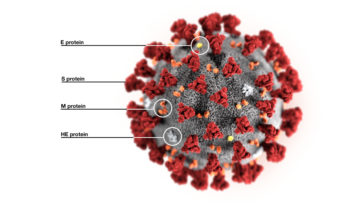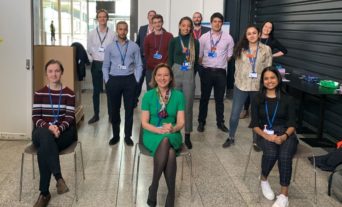On the 30 March, we found ourselves – as part of a group of clinical medical schools – at the Excel conference centre. If the year had progressed as planned, we should have been on placements across Oxfordshire and working in a hospital on the Solomon Islands. Instead, we were in a huge conference centre being rapidly transformed into a 4,000-bed field hospital. Following the closure of our medical school a week before, we received an email from Dr Tim Littlewood and Dr Rachael Liebmann asking for students to help with staff testing at the newly announced NHS Nightingale.
During our training, we learnt that an intensive care patient will have 42 samples collected per week. Doing some quick maths, we realised that for 4,000 patients, this would mean we would have to process 24,000 samples per day.
Soon after meeting Rachael, we found out that testing clinical staff was no longer the priority for us since this was being carried out by others. Instead, we were needed to set up the pathology lab at the Nightingale. Flexibility was certainly a key learning point in our experience at the Nightingale. We were told to expect the hospital to be filled within a number of weeks. With that in mind, we completed our pathology reception training – this would ordinarily take six weeks but we did it in just three days thanks to the lab staff at the Royal London Hospital. This involved learning to process samples for biochemistry, haematology, coagulation, blood transfusion, microbiology and virology testing. During our training, we learnt that an intensive care patient will have 42 samples collected per week. Doing some quick maths, we realised that for 4,000 patients, this would mean we would have to process 24,000 samples per day. This would be perhaps more than the 11 medical students could handle – at this rate we would have to roster the whole clinical school.
The first patient arrived in our second week at the hospital. Charlie received the first set of bloods on the night shift, not long before receiving a call from the ward staff. The point-of-care testing machines were failing to run samples and we were due to receive training on maintenance for these machines at 9am the next morning. Understanding that patient safety was at risk, Charlie rang the on-site maintenance phone number, which unfortunately was also due to be set up the following morning. He escalated this to Dr Liebmann, who sent out a national alert for guidance, no doubt disturbing many people’s sleep to help him. The machines were fixed remotely, a backup courier system was set up, and within two days we were teaching point-of-care testing to the ward staff. This was unsurprisingly one of many teething problems that arose.
We accrued more responsibilities in addition to processing blood samples, including managing blood for transfusion and teaching incoming staff. The irony of social distancing in spaces adorned with photos of the previously packed venue was not lost on us. The teaching faculty were looking to train up to 1,000 people a day in intensive care skills, including the use of blood gas machines. The trainees ranged from flight attendants to experienced intensive care consultants who months before could have been our examiners. Working at the Nightingale was a new experience for everyone. This shared experience of unfamiliarity led to a uniquely supportive and cooperative team environment. This was no doubt as a result of the ever-present Wellbeing team providing support in this stressful intensive care setting. And feeding us chocolate instead of salad.
Working at the Nightingale has been rewarding and formative in ways that are hard to convey in writing.
During our time at the Nightingale we were encouraged to attend clinical governance meetings to feedback any problems we had encountered. This provided a unique insight into the strategy and outlook of the hospital from a regional and national perspective. One problem we encountered was having to reject blood transfusion samples because the relevant form hadn’t been submitted with them. The next day reminder signs were seen throughout the hospital.
Fortunately, London fared better than was expected, and at the time of writing the Nightingale is on standby, ready to respond if needed. Working at the Nightingale has been rewarding and formative in ways that are hard to convey in writing. During the 6 weeks at the Nightingale, Charlie became a doctor – he could never have anticipated that in his first job out of medical school he would help manage a new department in the middle of a pandemic. From the warmth of staff working in the boulevard to witnessing the mammoth task of setting up a functioning hospital, our time at the Nightingale will undoubtedly shape our future careers.




